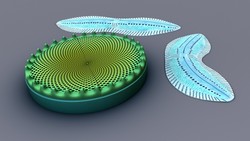Proteins excel at hard tissue engineering
Proteins can construct both hard and soft tissue but the hard tissue area is understudied. Difficulties in studying protein structure and function at inorganic solid surfaces means there is remarkably little known of the special molecular structure-function relationships that govern biomineralisation. The BIOSILICA FORMATION (A multi-spectroscopic investigation of protein structure in biosilica composites) project looked at the molecules involved in addition of silicate to the cell walls of diatoms. Specifically, the project aimed to elucidate the molecular recognition mechanisms harnessed by the proteins. Significantly, diatoms can synthesise nanophase silica structures in their home environment – at room temperature in sea water. Material scientists have to use extraordinary conditions such as extreme temperature and pH. The research programme covered protein recognition for mineral phases, protein architecture at interaction sites with minerals and the activity of amino acid side chains during orientation of proteins at mineral interfaces. Researchers adapted a range of spectroscopies normally used in biomaterial study. Using sum frequency spectroscopy, solid state nuclear magnetic resonance, electron microscopy and simulations, they looked at how basic peptides exert an influence on biomineral structures. BIOSILICA FORMATION scientists used a series of lysine-leucine peptides, reporter molecules as well as a repeat unit of the diatom protein silafin to look at their interaction with minerals and precipitation. Research results show details of side chain-surface structure during biomineralisation. When complete with interfacial folding, the resulting silica morphology in particles and thin films of width at nanometre level can be modelled. The BIOSILICA FORMATION study has uncovered the part played by proteins in biomineralisation. This newly developed knowledge platform will serve as a blueprint for the design of biomaterials and biomedical devices.







